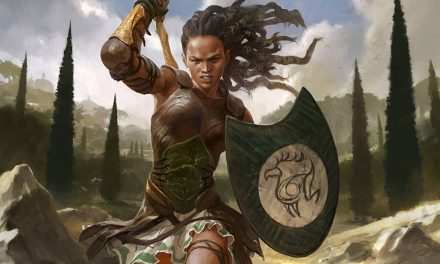In the whispy dream-like realm of the Feywild, one might find beings with knowledge from far before the mortal races were born. These beings are known as the Archfey and they just so happen to be willing to make a deal…
If mind-affecting magic and Fey tricks are up your alley, then this is for you.
This is the full subclass guide to the Archfey Warlock in D&D 5e!
What is the Archfey Warlock in D&D 5e?
While there are many powerful beings that call the Feywild their home, none are more powerful than the Archfey. These beings are able to rival some minor deities in terms of their abilities and influence.
However, we are still talking about Fey creatures here… It’s unlikely that an Archfey Warlock will ever truly understand their Patron’s goals, motivations, or methods!
Some common Archfey patrons include Titania of the Summer Court, Oberon the Green Lord, the Queen of Air and Darkness, and Hyrsam the Satyr Prince of Fools.
Of course, you might choose to take a bit of a darker route with such a patron…
The oldest and most powerful Hags are able to become Archfey Warlock patrons. In such a scenario, your character might be attempting to work off a debt owed to the hag.

Role in the Party
Archfey Warlocks are very strongly focused on spellcasting.
While they’re just as capable of bombarding enemies with Eldritch Blast as any other Warlock, these characters prefer to focus on spells that enchant others and can control the battlefield.
In true Fey style, the Archfey Warlock always keeps a trick up its sleeve! The magical abilities granted to them by their patron are enough to completely overwhelm their enemies’ senses.
This does open up a bit of utility casting for the Archfey Warlock though. Just like they can think outside of the box to take care of enemies, they can find unique magical solutions to other problems as well.
A bit of charm here and some illusion there could be all it takes to completely avoid a dangerous scenario!
With a high charisma and bag of tricks, the Archfey Warlock can also make an excellent face for the party!
Related: The Complete Class Guide to the Warlock in D&D 5e!
Archfey Warlock Features in D&D 5e
Most of the Archfey Warlock’s abilities require their targets to make Wisdom saves.
You’ll want to focus on enemies with low Wisdom scores while keeping a backup plan handy in case they’re able to see through your tricks!
Admittedly, the Archfey Warlock’s abilities tend to be more situational. However, when those situations arise you’ll be glad you have them!
Expanded Spell List
As an Archfey Warlock, your patron grants you additional spells. These spells are particularly focused on enchanting others and clever illusions, though there are some with different uses.
| Spell Level | Spells |
| 1 | Faerie Fire, Sleep |
| 2 | Calm Emotions, Phantasmal Force |
| 3 | Blink, Plant Growth |
| 4 | Dominate Beast, Greater Invisibility |
| 5 | Dominate Person, Seeming |
Faerie Fire and Sleep are excellent first-level spells. Sleep can potentially be an instant combat-ender, especially at lower levels. Meanwhile, Faerie Fire will help you deal with invisible enemies while also giving you and your party advantage on their attacks.
Calm Emotions is kind of so-so. When it’s useful, it’s wonderful, but those moments tend to be incredibly rare. Phantasmal Force, on the other hand, is a solid level 2 spell that can be incredibly powerful with some creativity.
Your level 3 spells are interesting. Blink is a 50/50 chance of the effect working but can be used to cause trouble and make a quick getaway.
Plant Growth, on the other hand, is a weird inclusion. It’s got some good out-of-combat uses, but you might want to just leave that to the Druid. A spell like Hypnotic Pattern would have been a much better inclusion, in my opinion.
Greater Invisibility is simply a fantastic spell. Being able to stay invisible while attacking and casting spells is great. Dominate Beast on the other hand is kind of a “meh” spell. There aren’t too many beasts by the time you’re able to cast this that are worth the spell slot.
Dominate Person, however, is a great way to turn the tables in a situation. That’s one you’ll definitely want to keep handy.
If you’re feeling really mischievous, Seeming can be used to cause all kinds of trouble. I don’t know that it should be a part of your adventuring spell list, but it can be great in sessions with more roleplaying.
Fey Presence (Level 1)
Your level 1 Archfey Warlock feature makes for a solid defensive option that can also be helpful in roleplaying encounters.
As an action, you can cause each creature in a 10-foot cube originating from you to make a Wisdom saving throw against your Warlock spell save DC. The creatures that fail their saving throws are all charmed or frightened by you (your choice) until the end of your next turn.
The range on this feature is a bit rough since you’re likely towards the back of the party in combat. Still, it’s a useful trick if you find yourself surrounded and need to make a quick escape.
In combat, choosing the Frightened condition will serve you better than charming your enemies. Out of combat, however, this can be a quick way to make some fast friends with the charm effect.
Fey Presence only lasts for a round, but if you think and act fast that should be plenty of time! It also resets on a short or long rest, so you should always have this trick up your sleeve.
Misty Escape (Level 6)
If Fey Presence wasn’t enough of a getaway when things go bad, now you’ve got an even better option!
When you take damage, you can use your reaction to turn invisible and teleport up to 60 feet to an unoccupied space you can see. You remain invisible until the start of your next turn or until you attack or cast a spell.
Ok, so it’s a little weird to get another defensive option back-to-back, but it’s not like having options is a bad thing!
If an enemy smacks you, this lets you vanish in a puff of smoke and completely change your positioning. Like Fey Presence, this resets when you take any rest so you should always have this ready as a “just in case” tactic.
Just be mindful that you still take the damage when you use Misty Escape. While it can prevent you from taking more damage from additional attacks, you’re not getting away completely unscathed.
Still, I’d say this glass is half-full!
You’re able to safely reposition without the threat of taking more damage this round unless the enemies can see through your invisibility.

Beguiling Defenses (Level 10)
Only a fool would attempt to charm an Archfey Warlock!
You are immune to being charmed.
When another creature attempts to charm you, you can use your reaction to attempt to turn the charm back on that creature.
The creature must succeed on a Wisdom saving throw against your Warlock spell save DC or be charmed by you for 1 minute or until the creature takes any damage.
On one hand, Beguiling Defenses is a really cool feature. Few things are as fun to turn back on another character as charms!
But on the other hand, it’s an oddly specific situational ability that you probably won’t get to use very often or even at all depending on what kind of adventure you’re playing. Naturally, a campaign with more Fey beings (who are fond of charms) will see this being used far more often.
It’s a cool bit of flavor, but admittedly lacking in the usefulness department for a level 10 feature.
Dark Delirium (Level 14)
The Archfey Warlock’s capstone feature lets you trap a creature in a realm of misty illusions of your choice.
As an action, choose a creature that you can see within 60 feet of you. It must make a Wisdom saving throw against your Warlock spell save DC.
On a failed save, it is charmed or frightened by you (your choice) for 1 minute or until your concentration is broken (as if you are concentrating on a spell.)
This effect ends early if the creature takes any damage.
Until this illusion ends, the creature thinks it is lost in a misty realm, the appearance of which you choose. The creature can see and hear only itself, you, and the illusion.
So this effectively works in a manner similar to the Banishment spell. Because it recharges on a short or long rest, it means you’ve basically always got a mini-Banishment ready to go.
It’s hard to overstate how useful removing an enemy from combat for a full minute is if you can maintain concentration.
If the creature is immune to being charmed or frightened, you’ve still isolated them from their allies. Just be sure to cast Greater Invisibility on yourself so they aren’t attacking you in that case.
In an out-of-combat situation, you can use this to help your attempt to persuade or intimidate someone. The illusionary world that you create is entirely up to you, so that can be useful.
If you’re trying to persuade someone then you might make an environment that’s more calm and relaxing.
Need to scare the wits out of them? You can just as easily make some kind of twisted nightmare realm to back up your intimidation.
Dark Delirium may not be the most incredible of capstones, but it can be incredibly fun and stylish!

Pact Boons for Archfey Warlocks
You’ll be choosing a Pact Boon at level 3. This grants you new abilities and opens up new Invocation options for you to take.
I wrote a different article that covers Warlock Pact Boons in D&D 5e in more detail. I recommend checking that out no matter what type of Warlock you’re looking to play.
However, it’s worth checking out the different Pact Boons as they relate to the Archfey Warlock.
Now that we’ve looked over the Archfey Warlock’s features, we want to find a Pact Boon that has good synergy with your fey tricks!
Pact of the Blade
An Archfey Warlock that takes the Pact of the Blade to fight on the frontlines is an interesting idea. However, it just doesn’t flow particularly well in practice.
Your charms are defensive but you’re greatly reducing their use by then attacking the creature. Remember: you’re a controller, trickster, and face for the party. It’s probably best if you’re not on the front line!
Archfey Warlocks should pass on the Pact of the Blade.
Pact of the Chain
All in all, the Pact of the Chain is always a solid option. Your familiar opens up a ton of new tactics for you in combat while also giving you a reliable scout.
The sprite and pseudodragon familiars perfectly fit the theme of your character. If we’re splitting hairs, I’d say that the imp is still the optimal choice though. You might be able to re-flavor the imp to better fit the Fey theme with your DM or just explore what the other options are capable of.
The Pact of the Chain is a strong pick for the Archfey Warlock. If you go with this or the Pact of the Tome, you’ll be in good shape!
Pact of the Talisman
The extra bonuses you gain from the Pact of the Talisman are nice, but there’s just not a great deal of synergy with the Archfey Warlock.
It’s not a bad option, but you’re better off with the Pact of the Chain and the Pact of the Tome. Those offer more for how the Archfey Warlock plays.
Pact of the Tome
As a caster, the Pact of the Tome is a fantastic option for you.
Gaining extra cantrips from any spell list is a great way to expand your repertoire. Whether you’re looking for more utility or ways to mess with the minds of others, you’ve got plenty of options! I’d especially recommend prioritizing Guidance if nobody else in your party has it.
The Invocations that you can get with the Pact of the Tome are great for improving your spellcasting performance.
If you’re wanting to go all-in on your role as a caster, this is the Pact Boon for you!
Related: The Best Warlock Invocations in D&D 5e
Connections
It’s difficult to understand Fey beings and the Archfey are certainly no exception.
Perhaps you mistakenly wandered into the Feywild and found yourself in one of the Fey Courts. Seeing some potential in you, an Archfey offered you a deal.
What kind of knowledge or power did you ask of the Archfey?
On the Material Plane, what do you do for your patron? Are their requests clear or vague? How does your patron communicate with you?
Considering the nature of the Fey, you’ve got a lot of room to get creative with how you connect your Archfey Warlock to the story and group.
Honestly, I’d really like to see how someone would play an Archfey Warlock with an ancient Hag as a patron… Perhaps even a being like Baba Yaga!
I still haven’t let go of that idea from earlier in this guide… It sounds so wonderful/horrible!
However you choose to do it, there should be a certain otherworldly vibe to your character. After all, one doesn’t interact with the Fey and walk away unchanged from the encounter!

Is the Archfey Warlock Good?
The Archfey Warlock is a good option for those who love really interacting with the world around them. While they’re fine enough in combat, they shine best in more roleplaying scenarios.
The biggest issue with the Archfey Warlock is just how situational their features are. It’s both the subclass’s biggest weakness and greatest strength.
Ultimately, the spells and invocations that you choose will be the most important factors in how your Archfey Warlock performs. Look for ways that you can aid your allies and shut down enemies to maintain control in combat.
If you do that, you’ll have a great time!
Want to see how the Archfey Warlock stacks up against the other Warlock Patrons? Check out my ranking of every Warlock subclass in 5e!
Conclusion – Guide to the Archfey Warlock in D&D 5e
With that, we conclude this guide to the Archfey Warlock in D&D 5e!
What are your impressions of this subclass? Let me know in the comments!
I’m a sucker for anything involving the Fey, so it’s nice to see an option that goes away from the standard dark Warlock vibes. As one of three Warlock options in the Player’s Handbook, I think it shows just how varied Warlocks can be right off the bat.
Want to stay up to date with the latest tips, tricks, guides, and more from Tabletop Joab? Sign up for my newsletter below!
You can also follow me on Facebook and Twitter.
If you found this article helpful and want to support the site, you can buy me a coffee here! (It’s not expected, but very appreciated!)









